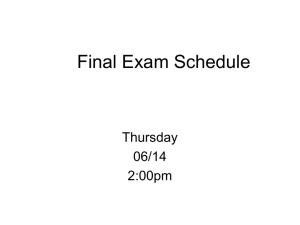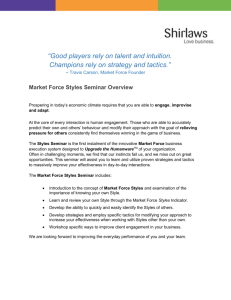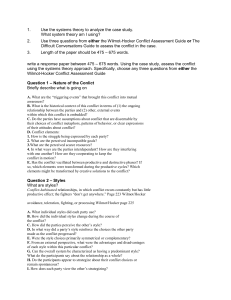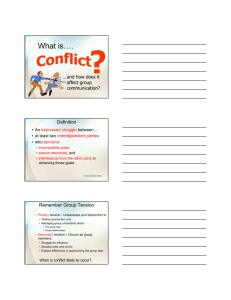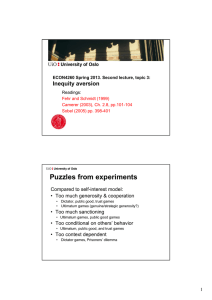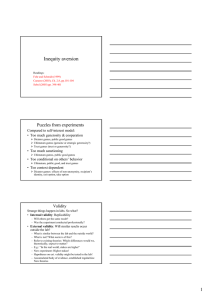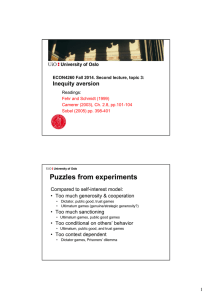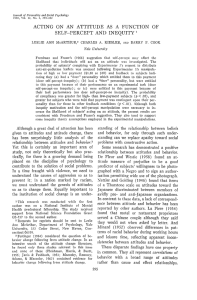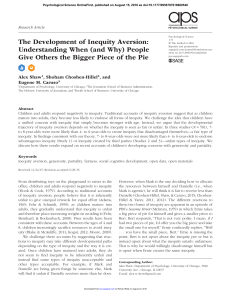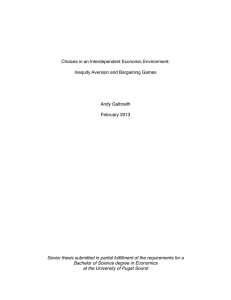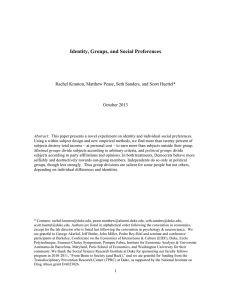Creates the motivation to change
advertisement
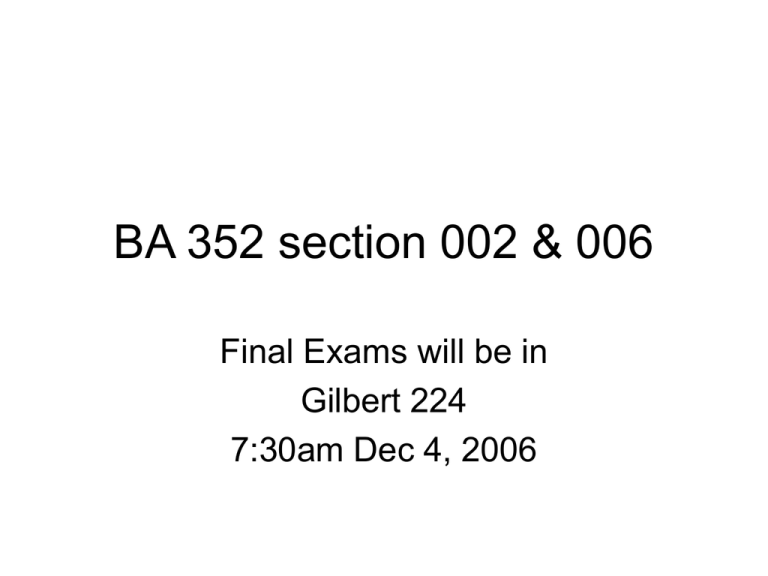
BA 352 section 002 & 006 Final Exams will be in Gilbert 224 7:30am Dec 4, 2006 Exam structure • 30 multiple choice questions • Emphasis will be later chapters – Ch 4, 7, 8, 9, 10, 11,12, 14, 16 – Some questions will be based on the Blackgold Cases, Bob Knowlton, L.E.S., and The Politics of Performance Appraisal • emphasis on APPLICATION of concepts in these chapters • bring your copies of these cases to exam • No questions on The Ropes . . . book Cases (Blackgold and other three) • There are opportunities to test how you can use concepts discussed in class to understand or explain the situations in these cases, e.g. – Social perceptions – Managing in an “e-business” – Motivating individuals, both those who work and do not work for you – Decision making, including game theory – How to deal with or manage conflict – Leadership style Tips • Questions will generally be in thef form of an application of a concept – When faced with this situation . . .? – This situation is called . . . ? • NOTE: The following slides are attempts to provide examples. Try to define a specific situation for the following: 7-2b Figure 7-1b Negative and Positive Inequity (cont) B. Negative Inequity Self $2 = $2 per hour 1 hour Other $3 1 hour = $3 per hour 7-2c Figure 7-1c Negative and Positive Inequity (cont) C. Positive Inequity Other Self $3 = $3 per hour 1 hour $2 = $1 per hour 1 hours 8-5 Nontraditional Feedback Upward Feedback: Subordinates evaluate their manager’s style and performance. 360-Degree Feedback: Specific (typically anonymous) feedback generated by one’s manager, peers, subordinates, and other key people. For group discussion: Are you in favor of this trend toward nontraditional feedback? Explain. What are its limits? 10-3a Figure 10-1 Tuckman’s Five-Stage Theory of Group Development Performing Adjourning Norming Storming Forming Dependence/ interdependence Independence Return to Independence 16-3 Lewin’s Change Model •Unfreezing - Creates the motivation to change - Encourages the replacement of old behaviors and attitudes with those desired by management - Entails devising ways to reduce barriers to change - Creates psychological safety • Changing - Provides new information, new behavioral models, or new ways of looking at things - Helps employees learn new concepts or points of view - Role models, mentors, experts, benchmarking results, and training are useful mechanisms to facilitate change •Refreezing - Helps employees integrate the changed behavior or attitude into their normal way of doing things - Positive reinforcement is used to reinforce the desired change - Coaching and modeling help reinforce the stability of change 16-7a Resistance To Change Resistance to Change: an emotional/behavioral response to real or imagined work change. The leading reasons why people resist change are: • • • • • An individual’s predisposition toward change Surprise and fear of the unknown Climate of mistrust Fear of failure Loss of status and/or job security 13-2a Nine Generic Influence Tactics Rational persuasion. Trying to convince someone with reason, logic, or facts. Inspirational appeals. Trying to build enthusiasm by appealing to others’ emotions, ideals, or values. Consultation. Getting others to participate in planning, making decisions, and changes. Ingratiation. Getting someone in a good mood prior to making a request; being friendly, helpful, and using praise or flattery. Personal appeals. Referring to friendship and loyalty when making a request. 13-2b Nine Generic Influence Tactics Exchange. Making express or implied promises and trading favors. Coalition tactics. Getting others to support your effort to persuade someone. Pressure. Demanding compliance or using intimidation or threats. Legitimating tactics. Basing a request on one’s authority or right, organizational rules or polices, or express or implied support from superiors. 11-3a Antecedents of Conflict • • • • • • • Incompatible personalities or value systems. Overlapping or unclear job boundaries. Competition for limited resources. Interdepartment/intergroup competition. Inadequate communication. Interdependent tasks. Organizational complexity. 11-3b Antecedents of Conflict (continued) • Unreasonable or unclear policies, standards, or rules. • Unreasonable deadlines or extreme time pressure. • Collective decision making. • Decision making by consensus. • Unmet expectations. • Unresolved or suppressed conflict. 11-6 Figure 11-1 Minimizing Inter-group Conflict: An Updated Contact Model Level of perceived Inter-group conflict tends to increase when: • Conflict within the group is high • There are negative interactions between groups (or between members of those groups) • Influential third-party gossip about other group is negative Recommended actions: • Work to eliminate specific negative interactions between groups (and members). • Conduct team building to reduce intragroup conflict and prepare employees for cross-functional teamwork. • Encourage personal friendships and good working relationships across groups and departments. • Foster positive attitudes toward members of other groups (empathy, compassion, sympathy). • Avoid or neutralize negative gossip across groups or departments. 11-8 Figure 11-2 Concern for Others Five Conflict-Handling Styles High Integrating Obliging Compromising Low Dominating Avoiding High Low Concern for Self Source: MA Rahim, “A Strategy for Managing Conflict in Complex Organizations, Human Relations, January 1985, p 84. Used with author’s permission. These type of topics may lend themselves more to “definition type” questions 8-3 Ch 8: Feedback Feedback: “Objective information about individual or collective performance.” Functions of Feedback: - Instructional - Motivational Sources of Feedback -Task -Self - Others 14-2b Trait Theory (continued) • Gender and leadership - men and women were seen as displaying more task and social leadership, respectively - women used a more democratic or participative style than men, and men used a more autocratic and directive style than women - men and women were equally assertive - women executives, when rated by their peers, managers and direct reports, scored higher than their male counterparts on a variety of effectiveness criteria 14-3 Behavioral Styles Theory • Ohio State Studies identified two critical dimensions of leader behavior. 1. Consideration: creating mutual respect and trust with followers 2. Initiating Structure: organizing and defining what group members should be doing • University of Michigan Studies identified two leadership styles that were similar to the Ohio State studies - one style was employee centered and the other was job centered • Blake and Mouton’s Managerial Grid represents four leadership styles found by crossing concern for production and concern for people • Research shows that there is not one best style of leadership. The effectiveness of a particular leadership style depends on the situation at hand. 11-4 Desired Outcomes of Conflict Agreement: Strive for equitable and fair agreements that last. Stronger relationships: Build bridges of goodwill and trust for the future. Learning: Greater self-awareness and creative problem solving.
